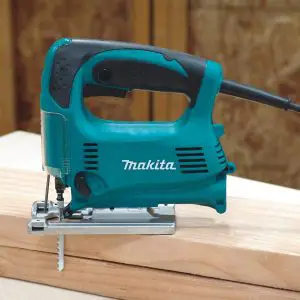Table of Contents
Introduction
A jigsaw is a handheld power tool used by professional builders and DIYers to cut into materials. It is easy to operate and mostly used in woodwork projects. It is one of the most versatile tools you can own because it is uniquely designed to cut through any material. The jigsaw is a type of saw that uses a reciprocating blade to cut curves into wood, metal, and other materials. It is used in many other projects, including floor installation, cutting pipes and metal, and cutting through aluminum, plastic, and countertops for sink installation. A jigsaw works by attaching a blade to it, and there are various types of blades for different projects. When using a jigsaw, the first thing to do is get the right type of blade for your project.
Also, see;
How to Use a Jigsaw
Choosing the right blade
There different types of blades that are designed for a specific type of material or project. Choosing the ideal blade is the first step when using the jigsaw. Most blades have been labeled with the type of material they can be used for. The carbon steel blade is the most popular type of blade. It is the standard blade used with the jigsaw and can cut through wood, PVC, and laminate. To cut through metal, use a bi-metal blade. A bi-metal blade is made with hardened steel teeth strong enough to cut through tough materials. Fine-toothed blades are used to make clean and accurate cuts. A coarse-toothed blade is mostly used to cut wood, and it leaves behind a rough surface. See Which Jigsaw Blades to Use? for the different types of blades you can use with your jigsaw.
Plug the saw or attach the battery
After getting your saw blade, the next thing to do is to power your jigsaw. If you have a corded model, plug the cord into a nearby power outlet, make sure it’s close enough to let you reach the areas you need to cut. You could get an extension box for more freedom when moving around. For the cordless type, insert the battery type into the port at the back of the machine.
Clamp the material to your work surface
You don’t want your material moving around when you are cutting. To avoid that, use a 2 C-clamp to hold the material and keep it steady. You can use additional clamps if the material is not stable enough. If you want to cut a hole in the center of the material, balance it between 2 sawhorses and then cut.
Start your saw
Look for the trigger on the handle and squeeze it to start the tool. Press down the trigger until you have finished cutting. If your jigsaw has a lock switch beside the trigger, use your thumb to lock the trigger to avoid squeezing it the whole time.
Adjust the cutting speed
To adjust the speed, use the dial at the front of the machine. If your jigsaw has a variable speed trigger, squeeze the trigger harder to increase the speed. Use a slower speed at first until you get used to using your jigsaw. It is advisable to cut metal or PVC at a slow speed to avoid melting the material, and you can use a faster speed to cut wood or laminate.
Mark the area you want to cut
Use a straightedge or a compass to trace a line on your material and then make your cut following that line. Cut along the outside of the line, so you don’t over cut the material. Hold the handle and place the jigsaw blade an inch away from the edge of the material before making your cut. To make a plunge cut, hold the saw perpendicular to the material and make a hole in the middle. This hole allows you to cut in any direction.
Your jigsaw blade may bind when making sharp curves on the wood; to avoid this, make relief cuts. To make relief cuts, stop the blade after making a short cut, remove it from the material and then make a fresh cut perpendicular to the cut line you left off.
Conclusion
Understanding how to use a jigsaw is not difficult. It is easy to handle and requires minimal skill to operate. The tool can serve many purposes and can be used in various projects. Follow the steps in the article to cut like a professional.

